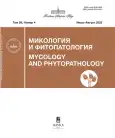In recent decades, there has been an increase in the severity of yellow rust of wheat worldwid (caused agent Puccinia striiformis f. sp. tritici). The aim of this work is to characterise the virulence and molecular polymorphism of Russian Pst populations in 2023. Leaves with P. striiformis f. sp. tritici urediniopustules were collected in the North-Western (Leningrad Region), North Caucasus (Dagestan, Krasnodar Territory) and Lower Volga regions (Saratov Region). Fourteen isogenic lines (AvocetNIL) and 15 differentiator varieties served as virulence testers. Twenty markers from Global Rust Research Centre were used in the microsatellite analysis. SCAR markers (SCP19M: 24a1, 24a2, 26a1, 26a2) were involved to search the invasive races PstS1 and PstS2. Virulence analysis included 70 isolates: 34 from Dagestan, 12 from Krasnodar, 6 from Saratov and 18 from Leningrad. The genes Yr5, Yr10, Yr15, Yr24 and Yr26 were characterized by high efficiency. An increase in virulence was noted for the Yr17 gene, which was previously effective in Russia. No significant changes in virulence frequencies were detected for the other Yr genes. Regional Pst populations in 2023, as well as in 2019–2022, were characterized by high phenotypic diversity. Forty-three phenotypes (races) were detected (23 in Dagestan, 3 in Krasnodar, 2 in Saratov and 17 in Leningrad). Two common virulence phenotypes were observed in the Krasnodar and Leningrad Pst collections. According to the Fst index, the Dagestan, Krasnodar, and Leningrad populations were characterized by high similarity; the Saratov population was moderately differentiated from them. Microsatellite analysis was performed for 55 isolates (28 from Dagestan, 18 from Leningrad, 6 from Krasnodar, 3 from Saratov). Polymorphism was noted for 10 out of 20 loci studied, and two alleles were detected in each of them. Significant deviations from the Hardy-Weinberg equilibrium were observed for 11 loci. Genotypic diversity of geographical populations for microsatellite loci was lower than by virulence test. The studied collection was represented by 20 multilocus genotypes (MGs) (Dagestan – 14, Leningrad – 7, Krasnodar – 2, Saratov – 1). Common MGs were found in Dagestan, Krasnodar and Leningrad Pst collections (MG_1); in Dagestan and Leningrad (MG_2); in Dagestan and Saratov (MG_3). Three MGs (4–6) were represented by two or more isolates, the rest by one isolate. As in the virulence analysis, the Dagestan, Krasnodar and Leningrad populations were characterised by high similarity in SSR markers (Fst index); the Saratov population differed moderately from them. According to Mantel’s test, there was a high correlation between virulence and microsatellite results (r = 0.93). Using SCAR markers, as in previous years, single isolates of PstS2 were identified in the Leningrad and Dagestan populations. The conducted complex analysis indicates high variability of yellow rust pathogen populations in Russia, which necessitates annual analyses of their polymorphism in virulence and SSR loci. Donors of highly effective Yr-genes can be recommended for use in breeding for resistance to yellow rust. The lack of differentiation between North Caucasian and Northwestern Pst samples indicates the existence of a single population in these territories.
 271-278
271-278


 279-287
279-287


 288-299
288-299


 300-312
300-312


 313-325
313-325


 326-332
326-332


 333-342
333-342


 343-351
343-351


 352-356
352-356











